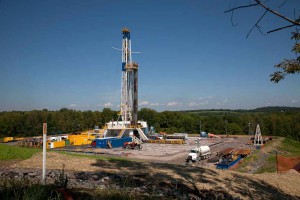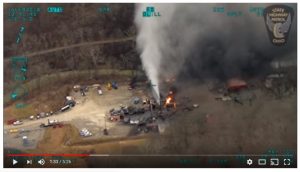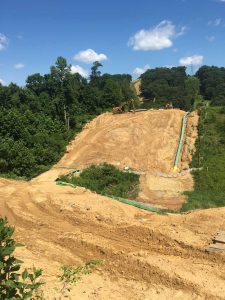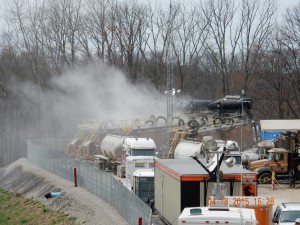- Like
- Digg
- Del
- Tumblr
- VKontakte
- Buffer
- Love This
- Odnoklassniki
- Meneame
- Blogger
- Amazon
- Yahoo Mail
- Gmail
- AOL
- Newsvine
- HackerNews
- Evernote
- MySpace
- Mail.ru
- Viadeo
- Line
- Comments
- Yummly
- SMS
- Viber
- Telegram
- Subscribe
- Skype
- Facebook Messenger
- Kakao
- LiveJournal
- Yammer
- Edgar
- Fintel
- Mix
- Instapaper
- Copy Link
 Our area is in the heart of the “shale gas revolution,” in which major new quantities of gas are being recovered from deep formations—here, the Marcellus and Utica shales—thus transforming our economy. Already these two shale plays are providing something like a third of the natural gas in the U.S., and are expected to produce an increasing share in the coming decades.
Our area is in the heart of the “shale gas revolution,” in which major new quantities of gas are being recovered from deep formations—here, the Marcellus and Utica shales—thus transforming our economy. Already these two shale plays are providing something like a third of the natural gas in the U.S., and are expected to produce an increasing share in the coming decades.
Besides the natural gas (methane), there is also a component referred to as “natural gas liquids” or NGL, (ethane, propane, butane and more), which can be sent to cracker plants that break it into smaller components, which then can go to factories to produce plastic, fertilizer and other chemicals. Hence the plans to build a giant new complex of pipelines, storage caverns, cracker plants, and chemical and plastics plants, all along the Ohio River from Southwest Pennsylvania to Huntington. Industry’s latest name for this complex is the Appalachian Storage and Trading Hub.
Given the ubiquitous, breathless and one-sided coverage in many area newspapers, you really don’t need me to detail the upside, but I’ll summarize the hype: the supply is plentiful, each component of this will provide jobs, most of which pay well, and it will also mean money in the coffers of local governments. The reality, on the other hand, is detailed below:
- The supply is not as abundant as often claimed, according to geologist David Hughes in his latest report Shale Gas Reality Check in which he painstakingly goes through the data, including data from each individual well, in each shale gas “play” and finds that the projections of the EIA (Energy Information Administration of the U.S. Energy Department) vary from moderately optimistic to extremely optimistic (both Marcellus and Utica are rated extremely optimistic).
- While there seem to be a lot of jobs in drilling and fracking and building pipelines, locals report that they see virtually exclusively out-of-state license plates on vehicles parked by these jobsites. And the jobs are dangerous, both to life and limb, and to health. Some, like pipeline construction, are short-term jobs. Furthermore, we’d see more jobs if we invested in renewable energy or energy efficiency—a lot more (which may be one reason we don’t see that investment—the suits like to talk about jobs when they’re addressing the public, trying to get us to accept destructive industries…but get them behind closed door and those jobs are “labor costs”).
- As for the money in local coffers, I’m sure the coal industry put money in county and state coffers, but they also got away with lobbying endlessly to have their taxes and fees reduced, as well as with simply not paying their property taxes.

Fracking truck accident. Photo by Ed Wade, Jr. or the Wetzel County Action Group
The downsides of the shale gas revolution are obvious to those living near fracking sites, gas power plants, pipelines, compressor stations, crackers, and chemical plants. They include contaminated water, sick family members and livestock, air, noise and light pollution, heavy traffic, road damage, plunging property values, forest destruction, creek pollution, loss of land from eminent domain, and fear of living right next to a well pad or a monster pipeline, (these things do sometimes catch fire or explode, or leak), along with the sheer ugliness of industrial zone development in what used to be a quiet and peaceful rural setting.
Landowners suspect that the “public need” that justifies the eminent domain taking of their land is really the companies’ need to make better profits by exporting the gas—and exports are way up.
On top of all the local problems, there is the issue of climate change. Many of those pushing these projects pretend to believe that gas development is a good thing because burning gas produces only 50 to 60% of the carbon dioxide of burning coal. Not as good as solar or wind maybe, but those “aren’t ready yet” so this is a “bridge to a clean energy future,” right? The answer is “nope. Unequivocally no, nyet, nein, non.” First, building all this gas infrastructure isn’t necessarily coming at the expense of the coal industry; instead, much of it is coming in instead of renewables. At this point, coal simply can’t compete, economically, with gas or renewables. Increasingly renewables are competitive with gas, too.
 In addition, while indeed burning gas produces less carbon dioxide than coal, the leaks of methane all along the supply route from the wells to the plant can actually make gas worse in the climate impacts category than coal, because methane is a much more potent greenhouse gas. It’s also shorter lived—it will all be gone within 20 years whereas some of the carbon dioxide will still be in the atmosphere warming the Earth for a thousand years. This is why you see such different numbers for how much worse the methane is—it depends on what time-frame you choose. Typical estimates are that the break-even point between gas and coal comes when about three percent of the methane leaks. The industry, and government, generally use a figure of 1.2 to 1.6% leakage, based on a study or two done in cooperation with the industry. But Robert Howarth, a professor at Cornell University, has done several studies showing that leakage rates are far greater than the industry-led study claimed, and other studies have backed him up. Some say 6%; Howarth thinks it may be as high as 12 %. Here’s a Joe Romm piece with links to several studies.
In addition, while indeed burning gas produces less carbon dioxide than coal, the leaks of methane all along the supply route from the wells to the plant can actually make gas worse in the climate impacts category than coal, because methane is a much more potent greenhouse gas. It’s also shorter lived—it will all be gone within 20 years whereas some of the carbon dioxide will still be in the atmosphere warming the Earth for a thousand years. This is why you see such different numbers for how much worse the methane is—it depends on what time-frame you choose. Typical estimates are that the break-even point between gas and coal comes when about three percent of the methane leaks. The industry, and government, generally use a figure of 1.2 to 1.6% leakage, based on a study or two done in cooperation with the industry. But Robert Howarth, a professor at Cornell University, has done several studies showing that leakage rates are far greater than the industry-led study claimed, and other studies have backed him up. Some say 6%; Howarth thinks it may be as high as 12 %. Here’s a Joe Romm piece with links to several studies.
Okay, so natural gas is not a bridge to clean energy, it’s a detour away from it, a delay we really can’t afford. It has all kinds of local harms, in return for some jobs that are apparently mostly going to people from far away. While having those guests here for a while does mean income for owners of restaurants and motels and campgrounds, they have also brought a spike in crime rates, and spending for infrastructure likely to be abandoned when the boom is over.
We can expect the wells and other infrastructure to also be abandoned—why should the gas industry be any different than the coal industry? Why should we expect DEP to make the gas industry pay bonds sufficient to actually reclaim their damaged sites, when they’ve never done so for the coal industry? West Virginia has many thousands of abandoned conventional wells, some of them never capped.
So we’re making all these sacrifices just so the gas industry can rake in the profits? Well, no—here’s where it gets kind of weird. The truth is, this industry is not profitable—they’ve been losing money steadily from the beginning, struggling each year to at least pay the interest on their loans, so they can get enough new loans to keep drilling, so they’ll have money to pay off their loans.
Part of the problem is that the “miraculous” new techniques that allow the recovery of previously inaccessible shale gas are expensive. And part of it is that unlike conventional wells, shale wells decline very rapidly, so they have to keep drilling more and more wells just to maintain production. This is called the “Red Queen Effect,” as chronicled by DeSmog Blog here. The blog answers that question you no doubt have: why in hell would they keep drilling, and why would banks keep giving them loans, if it’s a losing proposition? According to this series, it seems to be because the banks make money on fees for loans, whether the money is paid back or not. In essence, the shale industry is the new subprime housing bubble for Wall Street. And the top guys at each gas company also make big bucks, whether their companies are profitable or not.

Okay, so let’s get this straight: We’re seeing our beautiful hills torn apart, our creeks muddied and polluted, our wells contaminated (but good luck proving it), our towns beset by short-term workers with little interest in the well-being of the community, our economy locked into yet another destructive extractive industry, and the climate damaged to the point our children will despise our memory—all so a few rich investors and CEOs can get even richer?
Crazy, isn’t it?
One more thing: there’s the opportunity cost. Instead of sticking stubbornly to the destructive fossil fuel economy, we could be investing in a clean energy future, like so many other places are doing. A better economic vision would include investing in the production and installation of solar and windmills, in geothermal power and microhydro, in storage technologies, in energy efficiency (of buildings and water heating and appliances and vehicles), in farming techniques that are healthier for the workers and the consumers and sequester carbon, in alternatives to the plastic that’s creating such a threat to sea life. We could invest not only money but materials, workers, and the last of the fossil fuel energy in producing all this… some of it requires a lot of energy and we don’t yet have enough clean energy sources to power the transition. This is where the last of the fossil fuel energy should be going, instead of into a mindless, business-as-usual blast out our tailpipes, leaving our children to struggle in a polluted world with little but candles and horses for energy.
Investing in a transition would put a lot more people to work, in safer jobs that don’t poison their neighbors. And we need to do it yesterday. Unfortunately, the handful of wealthy sociopaths determined to extract the last possible profits from their fossil fuel holdings, have been able to use the power of their wealth to block any such transition. They know how to grease Congress, legislatures, and the media. It’s still a relatively small group who are fully aware of this critical struggle. If you haven’t joined us yet—now’s the time!










Great essay; shot through with both reason and passion!